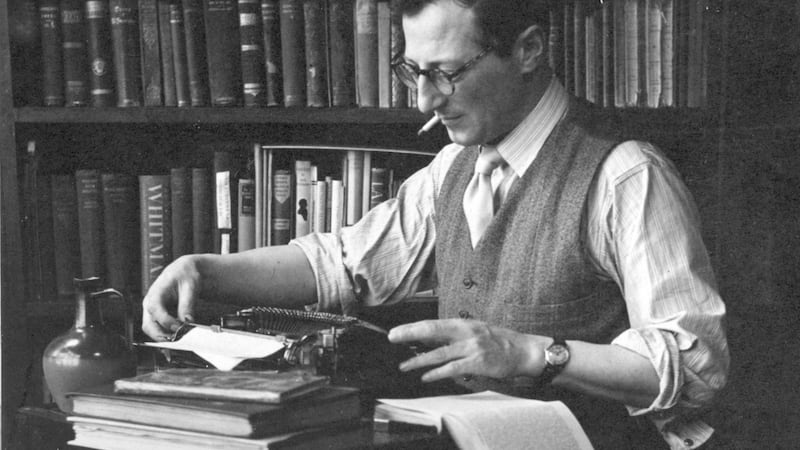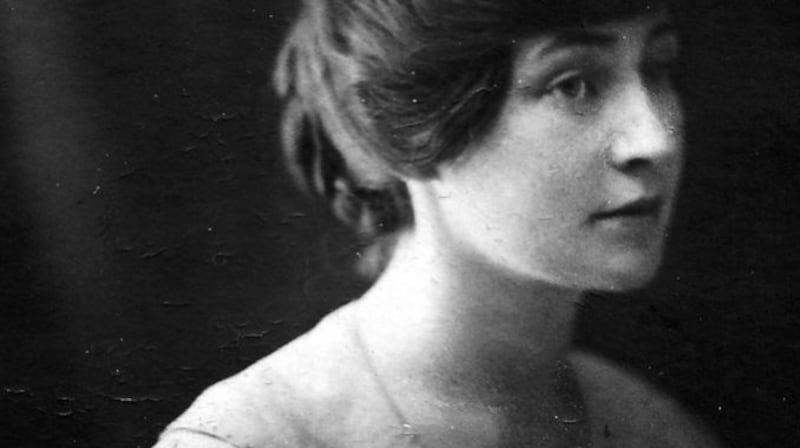One of the remaining mementoes of Irish literary involvement in the Spanish Civil War is housed in the archives of the Marx Memorial Library, London.
A sepia photo captures, in amber, poet Ewart Milne, standing in front of a battered medical supplies lorry. Milne is not alone. He is in the company of Wogan Philipps, Stephen Spender, George Green and Izzy Kupchik. The group represent, in visual shorthand, the sheer diversity of volunteers in Spain during the years 1936-9. There is the aristocratic Phillips, who, as Lord Milford, would later become the only communist peer in the House of Lords; the upper-class poet Spender; working-class orchestral musician George Green; and Canadian-Jewish ambulance driver Izzy Kupchik.
All except Kupchik would write in one way or another about their searing experiences in Spain. Kupchik as a war casualty, would later be memorialised in poem and prose by both Milne and Phillips. The medical supplies lorry behind them bears the legend “Medicamientos Por Los Obreros de Espana”. The photo was probably taken in February 1937. Everyone but Milne is similarly attired in the photograph. Milne is the exception. He is in civvies, wearing a greatcoat, shawl-collared jumper, and poised, with a notebook in his hand, not smiling.
The photograph subtly captures the ambiguities of Milne’s place in the Spanish conflict. His defiant clasp of the notebook seems to signal the identity of “writer” as taking priority over other activities. Many years later, after he retreated from his political choices in the Thirties, he would admit that the poems he wrote were what was most important to him about the Civil War episode in his life.
Yet, for all his tetchy disavowals of socialism, his stories and poems, forged in the crucible of the war and burned in the memory by the sorrows of loss, form a key part of that small body of Spanish Civil War writing by Irish men and women, texts which also perform acts of witness, memorial, solidarity and elegy.
Milne is one of a cultural quartet who form the main subject of the book Irish Writers and the Thirties but they are also part of a much broader circle of Irish writers seeking to redefine themselves through internationalism in the 1930s, with the Spanish Civil War just one strand in a hidden cultural history that emerged as I dug deeper in a number of archives in Ireland and England.
What these archives revealed was a dense web of connections from Dublin to London to New York, to wartorn Spain and to the USSR. By situating the Irish writers within different political and cultural groups, it became easier to identify that they could often think and act at local, national and international levels.
Irish writers in 1930s London, for instance mingled in interlocking influential cultural circles with figures as diverse as TS Eliot, George Orwell, Dylan Thomas, Nancy Cunard and a host of British leftwing cultural activists such as Montagu Slater and Edgell Rickword, who were connected to the Left Review, a publication re defining cultural parameters in the Thirties. Amongst its pages, fierce debates took place on the nature of culture, working-class writing and ways to combat fascism. Charles Donnelly and Peadar O’Donnell wrote for a special Left Review edition themed on Irish Freedom in 1936.

I had first encountered the name of Leslie Daiken, whose archive has shaped the book, over 20 years ago when I interviewed his brother, Aubrey Yodaiken. I was looking for any trace of Jewish radicals in the Irish Jewish community, and not having much success. Daiken’s reputation at the end of his life was as jovial Toy-man – he was an expert on toys, games and wrote his last book about street rhymes – but this completely obscured his role in 1930s political and cultural circles, and his campaigning journalism with small groups of leftwing republicans, as part of Ireland’s radical cultural diaspora in London.
Only one obituary made reference to him as a worker in the cultural sphere, hinting at something more complex in his life trajectory. In his tribute to Daiken, Brian O’Neill, Irish Press journalist, observed: “He was always busy, always with a half dozen irons in the fire, always trying to give a hand to some Irish writer who needed it.”
When I interviewed Daiken’s brother Aubrey Yodaiken in the early 1990s, I little knew where that interview would lead me. I was left with a faint sense of melancholy, as my interviewee had become distressed speaking about his brother, Leslie Daiken, and recalling his irrepressible and exasperating personality, his many projects, half-started novels, a finished radio play about the Jewish community in the 1920s, broadcast on RTÉ in the early 1960s.
Yet the overarching impression was regret that his older brother had never achieved sufficient recognition for his cultural efforts in his lifetime. Daiken’s last post was with Conor Cruise O’Brien in the University of Ghana, in the audiovisual department, making educational films – O’Brien was a friend from schooldays. On leave in London, in August 1964 he complained of indigestion one night, went up to bed and died, aged 52.
The obituaries were masterpieces of elision and euphemism. There were comparisons to Pickwick and Leopold Bloom. But what was striking was the almost complete erasure of reference to the lively radical scene Daiken was part of in 1930s London and Dublin. Of course by then, many of his friends and comrades were dead, or disillusioned – Charles Donnelly killed at the battle of Jarama, Ewart Milne withdrawn into cranky contrarianism. There were few to bear witness to what Daiken called “heroic days of dream and struggle”, when “life was long continuum of agitprop”.
I got access to the Daiken archives at the National Library of Ireland in 2011. One item kept drawing me back. It is a giant scrapbook, stuffed to the gunnels with Daiken’s cuttings, articles, book reviews, educational posters – it looks almost like an old-style movie prop, where pages might fly open to reveal a key date for the movie action to start.
This archive proved to be a repository of lost dreams and ideals when Irish writers were part of a key cultural moment in the 1930s, and made their own valuable and idiosyncratic contributions, alongside many other writers who believed “Culture could make you better” (Margaret Atwood)
With more archival digging, and Daiken acting as literary Pied piper, a few other shadowy figures stepped into the light. Michael Sayers, who roomed with Orwell, carried out daring investigations into fifth columnists in America, prior to the United States joining the war.
Women writers with the kind of political and cultural pedigree I was after proved more elusive. Their record of their lives and work were not valued. There were stories of relatives unceremoniously chucking out letters and precious archives. Some like Hanna Sheehy Skeffington and Rosamond Jacob had been lucky to find fine biographers already, in Margaret Ward and LeeAnn Lane. In the case of other women, like Stella Jackson, also known as Stella Fitzthomas Hagan, evidence of their lives and writing have practically disappeared. Jackson’s existence was revealed in a cache of letters from her lover Ewart Milne, kindly loaned to me by Barbara Hussey, part of her husband Justin Keating’s archives. (Friends such as the extended Keating clan, the Daiken daughters, as well as strangers, were immensely generous with time, and sharing photos.)

Jackson did the research for her novel about Lord Edward Fitzgerald, The Green Cravat, while in wartime Ireland, staying with Milne and novelist Margaret Barrington in a house in Leap, Co Cork. In 2019 in a library in Salford, on the trail of something else entirely, I unearthed three large boxes of an unpublished memoir by Jackson, containing vivid reminisces of her years in Ireland, from 1939 to 1941, replete with sometimes scurrilous political and cultural gossip, tales of parties with Sean Keating and his wife May, literary editor of Ireland Today Ned Sheehy, and artist Harry Kernoff.
Jackson wrote of being smuggled into Dublin bars, the Palace and the Zodiac, observing the effect of neutrality on the general populace; and more unusually, looking for health food shops, as she was a “food reformer”.
There were spooky coincidences, strange discoveries, and a growing chorus of spectral voices clamouring for attention. In the end, one works with what one has. The terrain still bears further exploration and others to join in the literary and cultural dig. The 1930s is a decade in Irish history which remains almost uncharted, and what even one section of cultural history reveals is that it is rich and fertile territory for exploration.
Irish Writers and the Thirties Art Exile and War by Katrina Goldstone is published by Routledge in its Studies in Cultural History series.
Katrina Goldstone will give a lecture on Leslie Daiken and Michael Sayers: Irish Writers and the Thirties at the National Library of Ireland at 7pm today. Click here for details.





















